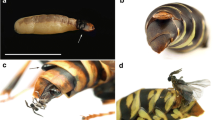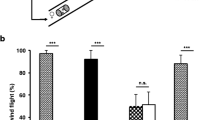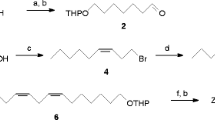Abstract
When hexane extracts of mature screwworm females were chromatographed on a silica gel column, mating stimulant activity was concentrated in a fraction that eluted with hexane-ether (94∶6, v/v). Separation of this fraction with HPLC (acetonitrile-acetone; 60∶40, isocratic) resulted in a chromatogram of some 20 peaks. Only peaks 4–11 elicited mating responses. Peaks 5–10 had most of the activity, with peak 8 producing the highest response. Sixteen compounds were characterized from peak 8 by gas chromatography-mass spectrometry: six unbranched secondary acetates (C31H62O2); seven previously unreported methyl-branched secondary acetates (C32H64O2); one unbranched ketone (C31H62O); and one methyl-branched ketone (C32H64O). The isomeric acetates were not completely resolved from each other by capillary gas chromatography (CGC) on methyl silicone columns. The sixteenth compound was an aldehyde (C30H60O) that was present only in occasional peak 8 preparations. These compounds and several derivatives were characterized by capillary gas chromatography-mass spectrometry (CGC-MS). The position of the acetate group was ascertained by conversion to a keto group or by replacement of the acetate with a methyl group. Pheromone activity was not observed in peaks trapped either from CGC or by recombination of the trapped CGC peaks from HPLC peak 8. This apparent loss of activity from CGC peaks or from TLC cannot currently be explained.
Similar content being viewed by others
References
Blomquist, G.J., Dillwith, J.W., andAdams, T.S. 1987. Biosynthesis and endocrine regulation of sex pheromone production in Diptera, pp 217–250,in G.D. Prestwich and G.J. Blomquist (eds.). Pheromone Biochemistry. Academic Press, Orlando, Florida.
Budzikiewicz, H., Djerassi, C., andWilliams, D.H. 1967. Mass Spectrometry of Organic Compounds. Holden-Day, San Francisco, xiv + 690 pp.
Carlson, D.A., andMackley, J.W. 1985. Polyunsaturated hydrocarbons in the stable fly.J. Chem. Ecol. 11:1485–1496.
Carlson, D.A., andSchlein, Y. 1991. Unusual polymethyl alkenes in tsetse flies acting as abstinon inGlossina morsitans.J. Chem. Ecol. 17:267–284.
Colthup, N.B., Daly, L.H., andWiberley, S.E. 1964. Introduction to Infrared and Raman Spectroscopy. Academic Press, New York, xii + 511 pp.
El-Azazy, O.M.E. 1989. Wound myiasis caused byCochliomyia hominivorax in Libya.Vet. Rec. 124:103.
Fletcher, L.W., O'Grady, J.J., Jr., Claborn, H.V., andGraham, O.H. 1966. A pheromone from male screwworm flies.J. Econ. Entomol. 59:142–143.
Gabaj, M.M., Wyatt, N.P., Pont, A.C., Beesley, W.N., Awan, M.A.Q., Gusbi, A.M., andBenhaj, K.M. 1989. The screwworm fly in Libya: A threat to the livestock industry of the Old World.Vet. Rec. 125:347–349.
Hammack, L. 1986. Pheromone mediated copulatory responses of the screwworm fly,Cochliomyia hominivorax.J. Chem. Ecol. 12:1623–1631.
Hammack, L. 1987. Chemical basis for asymmetric mating isolation between strains of screwworm fly,Cochliomyia hominivorax.J. Chem. Ecol. 13:1419–1430.
Hammack, L. 1991. Sex pheromone communication in the screwworm. Ontogenetic and strain effects.Cochliomyia hominivorax.J. Chem. Ecol. 17:2143–2154.
Howard, R.W., andBlomquist, G.J. 1982. Chemical ecology and biochemistry of insect hydrocarbons.Annu. Rev. Entomol. 27:149–172.
Krafsur, E.S., Whitten, C.J., andNow, J.E. 1987. Screwworm eradication in North and Central America.Parasitol. Today 3:131–137.
Laake, E.W.,Cushing, E.C., andParish, H.E. 1936. Biology of the primary screwworm fly,Cochliomyia americana, and a comparison of its stages with those ofC. macellaria. U.S. Department of Agriculture Technical Bulletin No. 500, 24 pp.
Mackley, J.W., andBroce, A.B. 1981. Evidence of a female sex-recognition pheromone in the screwworm fly.Environ. Entomol. 10:406–408.
Pomonis, J.G. 1989. Cuticular hydrocarbons of the screwworm,Cochliomyia hominivorax (Diptera: Calliphoridae). Isolation, identification, and quantification as a function of age, sex, and irradiation.J. Chem. Ecol. 15:2301–2317.
Pomonis, J.G., Nelson, D.R., andFatland, C.L. 1980. Insect hydrocarbons 2. Mass spectra of dimethylalkanes and effect of the number of methylene units between methyl groups on fragmentation.J. Chem. Ecol. 6:965–972.
Pomonis, J.G., Hakk, H., andFatland, C.L. 1989. Synthetic methyl- and dimethylalkanes. Kovats indices, [13C]NMR and mass spectra of some methylpentacosanes and 2,X-dimethylheptacosanes.J. Chem. Ecol. 15:2319–2333.
Rasmussen, J.R., Slinger, C.L., Kordish, R.J. andNewman-Evans, D.D. 1981. Synthesis of deoxy sugars. Deoxygenation by treatment withN,N'-thiocarbonyldiimidazole/tri-n-butylstannane.J. Org. Chem. 46:4843–4846.
Richardson, R.H., Ellison, J.R., andAverhoff, W.W. 1982. Autocidal control of screwworms in North America.Science 215:361–370.
Schwartz, D.P., andOsman, S.F., 1977. Applications of chromic acid-celite columns to micro- and semimicro preparations of fatty aldehydes.Anal. Biochem. 80:70–75.
Scott, D., Rollib, C.R., andCarlson, D.A. 1988. Pheromones exchanged during mating: A mechanism for mate assessment inDrosophila.Anim. Behav. 36:1164–1173.
Silverstein, R.M., Bassler, G.C., andMorrill, T.C. 1981. Spectrometric Identification of Organic Compounds, 4th ed. John Wiley & Sons, New York, 442 pp.
Snow, J.W., Whitten, C.J., Salinas, A., Ferrer, J., andSudlow, W.H. 1985. The screwworm (Cochliomyia hominivorax) (Diptera: Calliphoridae) in Central America and proposed plans for its eradication south to the Darilen Gap in Panama.J. Med. Entomol. 22:353–360.
Author information
Authors and Affiliations
Additional information
Mention of a proprietary or commercial product does not constitute an endorsement by the U.S. Department of Agriculture.
Rights and permissions
About this article
Cite this article
Pomonis, J.G., Hammack, L. & Hakk, H. Identification of compounds in an HPLC fraction from female extracts that elicit mating responses in male screwworm flies,Cochliomyia hominivorax . J Chem Ecol 19, 985–1008 (1993). https://doi.org/10.1007/BF00992533
Received:
Accepted:
Issue Date:
DOI: https://doi.org/10.1007/BF00992533




